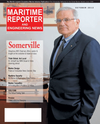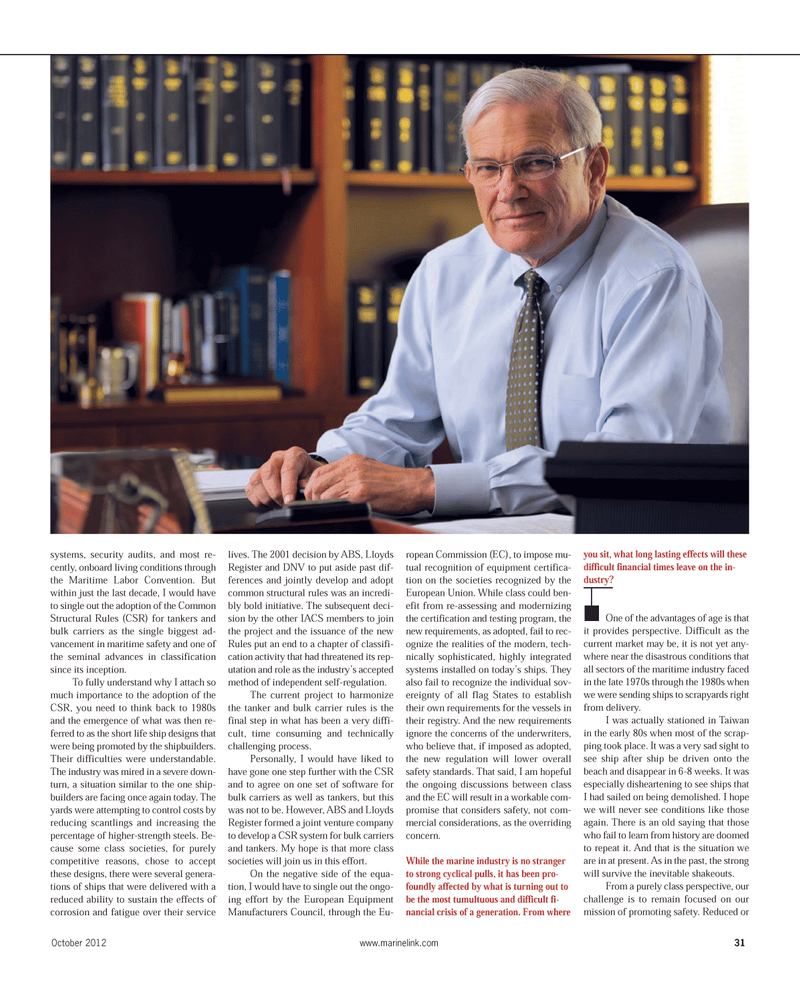
Page 31: of Maritime Reporter Magazine (October 2012)
Marine Design & Construction
Read this page in Pdf, Flash or Html5 edition of October 2012 Maritime Reporter Magazine
October 2012www.marinelink.com 31systems, security audits, and most re-cently, onboard living conditions through the Maritime Labor Convention. But within just the last decade, I would have to single out the adoption of the CommonStructural Rules (CSR) for tankers and bulk carriers as the single biggest ad- vancement in maritime safety and one of the seminal advances in classification since its inception.To fully understand why I attach so much importance to the adoption of theCSR, you need to think back to 1980sand the emergence of what was then re- ferred to as the short life ship designs thatwere being promoted by the shipbuilders. Their difficulties were understandable. The industry was mired in a severe down- turn, a situation similar to the one ship-builders are facing once again today. The yards were attempting to control costs byreducing scantlings and increasing thepercentage of higher-strength steels. Be- cause some class societies, for purelycompetitive reasons, chose to accept these designs, there were several genera- tions of ships that were delivered with a reduced ability to sustain the effects of corrosion and fatigue over their service lives. The 2001 decision by ABS, Lloyds Register and DNV to put aside past dif- ferences and jointly develop and adopt common structural rules was an incredi- bly bold initiative. The subsequent deci- sion by the other IACS members to join the project and the issuance of the new Rules put an end to a chapter of classifi- cation activity that had threatened its rep- utation and role as the industry?s accepted method of independent self-regulation. The current project to harmonizethe tanker and bulk carrier rules is the final step in what has been a very diffi- cult, time consuming and technicallychallenging process.Personally, I would have liked to have gone one step further with the CSR and to agree on one set of software for bulk carriers as well as tankers, but this was not to be. However, ABS and Lloyds Register formed a joint venture company to develop a CSR system for bulk carriers and tankers. My hope is that more class societies will join us in this effort. On the negative side of the equa- tion, I would have to single out the ongo- ing effort by the European Equipment Manufacturers Council, through the Eu- ropean Commission (EC), to impose mu-tual recognition of equipment certifica- tion on the societies recognized by theEuropean Union. While class could ben- efit from re-assessing and modernizing the certification and testing program, the new requirements, as adopted, fail to rec- ognize the realities of the modern, tech-nically sophisticated, highly integrated systems installed on today?s ships. They also fail to recognize the individual sov- ereignty of all flag States to establishtheir own requirements for the vessels in their registry. And the new requirements ignore the concerns of the underwriters,who believe that, if imposed as adopted, the new regulation will lower overall safety standards. That said, I am hopeful the ongoing discussions between classand the EC will result in a workable com- promise that considers safety, not com- mercial considerations, as the overriding concern.While the marine industry is no strangerto strong cyclical pulls, it has been pro- foundly affected by what is turning out to be the most tumultuous and difficult fi- nancial crisis of a generation. From where you sit, what long lasting effects will these difficult financial times leave on the in- dustry?One of the advantages of age is that it provides perspective. Difficult as the current market may be, it is not yet any- where near the disastrous conditions thatall sectors of the maritime industry faced in the late 1970s through the 1980s whenwe were sending ships to scrapyards right from delivery. I was actually stationed in Taiwan in the early 80s when most of the scrap-ping took place. It was a very sad sight to see ship after ship be driven onto the beach and disappear in 6-8 weeks. It was especially disheartening to see ships thatI had sailed on being demolished. I hopewe will never see conditions like those again. There is an old saying that those who fail to learn from history are doomed to repeat it. And that is the situation we are in at present. As in the past, the strong will survive the inevitable shakeouts. From a purely class perspective, our challenge is to remain focused on ourmission of promoting safety. Reduced or MR#10 (26-33):MR Template 10/4/2012 1:07 PM Page 31

 30
30

 32
32
